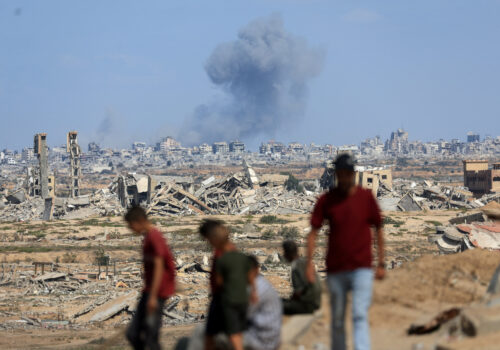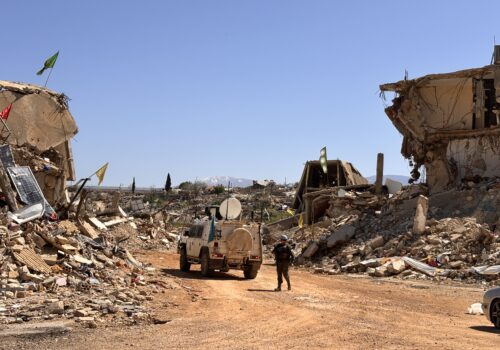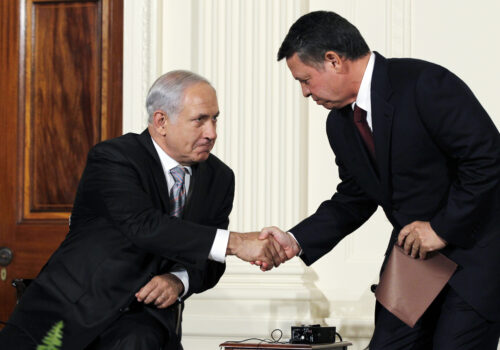Why Lebanon is stuck in the middle on Hezbollah disarmament
If the long-awaited ceasefire agreement between Israel and Hamas announced this week holds, bringing an end to the devastating two-year war in Gaza, international attention could refocus on Lebanon, where the government is struggling to disarm the powerful Hezbollah organization while the Israeli military continues a low-level campaign of near-daily airstrikes across the country.
Lebanese President Joseph Aoun welcomed the Gaza ceasefire agreement, while urging the international community to pressure Israel to halt its attacks on Lebanon, withdraw its troops from Lebanese territory, and abide by a November 2024 ceasefire deal that was supposed to end thirteen months of fighting between Israel and Hezbollah.
The Lebanese government currently finds itself caught between the rock of the United States pressuring for Hezbollah’s disarmament and the hard place of Hezbollah refusing to do so. The dilemma facing the Lebanese government is how to achieve the disarmament of an unwilling Hezbollah without dragging the country into civil strife, while doing so at a pace that satisfies an impatient US President Donald Trump and dissuades a bullish Israel from escalating its attacks into Lebanon.
Challenges for the Lebanese Armed Forces
On October 6, the Lebanese Armed Forces (LAF) produced the first monthly report on the process of disarming Hezbollah. While the contents of the report—conveyed during a Lebanese cabinet session by the LAF commander, General Rudolph Haykel—have not been publicly revealed, Culture Minister Ghassan Salameh called the update “excellent.”
In the first month of operations, the LAF has been working to remove arms and dismantle military infrastructure in the South Litani Sector (SLS), the area of the southern border district where the United Nations (UN) peacekeeping force, known as UNIFIL, is deployed. In that same time, the LAF also received weaponry held by the Fatah faction from several Palestinian refugee camps. Other Palestinian groups, such as Hamas, Islamic Jihad, and several Salafi jihadist factions, have refused to hand their weapons over.
SIGN UP FOR THIS WEEK IN THE MIDEAST NEWSLETTER
No final deadline was given in the LAF plan for the completion of Hezbollah’s disarmament. The LAF warned that it could only operate within its limited resources and that Israel’s continued occupation of parts of the SLS prevents a full army deployment in the area. The LAF has been badly affected by Lebanon’s economic collapse, now entering its seventh year, with the devaluation of the national currency having decimated monthly salaries. Not only is the LAF charged with the complex process of removing Hezbollah’s weapons and those of Lebanon-based Palestinian factions, it has to plan ahead for a major deployment into the SLS when UNIFIL’s mandate ends at the end of 2026 and the peacekeepers withdraw from Lebanon over the following twelve months.
The LAF is also responsible for security along Lebanon’s lengthy and often rugged border with Syria, further stretching its manpower shortage.
Hezbollah’s position
Hezbollah maintains that it is willing to discuss its arms in the context of a debate on a national defense strategy, but it refuses to unilaterally hand over its weapons while Israel remains on Lebanese soil.
In a July speech, Sheikh Naim Qassem, Hezbollah’s secretary-general, explicitly stated that there would be no negotiations over the party’s arms unless Israel “withdraws from the occupied [Lebanese] territories, stops its aggression, releases the prisoners, and reconstruction [of war-damaged areas] begins.”
“Only then,” he said, “will we be ready for the second stage, which is to discuss national security and defense strategy.”
Despite the pressure Hezbollah faces, it is hard to imagine that Hezbollah would voluntarily and unilaterally decide to disarm. The Islamic Resistance is the beating heart of Hezbollah, and the cornerstone of its entire raison d’être. While the party has other components such as its parliamentary presence, seats in government, and extensive social-welfare apparatus, these elements exist primarily to sustain and protect what Hezbollah calls its “resistance priority.” After all, Hezbollah did not emerge in the wake of Israel’s 1982 invasion of Lebanon to provide hospitals, schools, and clinics for the betterment of its Lebanese constituency. It was established as a military-religious organization, supported and guided by Iran, with the immediate goal of driving Israel out of Lebanon.
In the years after Israel withdrew from its “security zone” in south Lebanon in May 2000, Hezbollah gradually grew in strength and capacity to become a key component of Iran’s regional deterrence architecture. While Hezbollah took a battering in the recent conflict with Israel, Iran has not abandoned its protégé. Iran continues to support Hezbollah as the group seeks to reorganize and rebuild its capabilities. However, if Hezbollah gave up its weapons, regardless of the reason, it would no longer be able to threaten Israel and continue serving as a factor of deterrence for Iran. (One could argue that Hezbollah’s deterrence role was irretrievably weakened by the 2023-2024 conflict; yet Iran continues to back the organization and, therefore, still sees utility in its armed existence).
If a disarmed Hezbollah no longer serves a useful purpose for Iran, then there is no reason for Tehran to continue supporting the party with funding, weaponry, and logistics. But if Iran were to cease its financial support, how would Hezbollah continue to fund its vast social-welfare apparatus?
While Hezbollah has its own revenue streams, they may be insufficient to cover the enormous costs of running its networks of schools, hospitals, and clinics, and providing financial support to the families of “martyrs” and to wounded and disabled veterans. That could lead to the dismantlement of at least part of its social-welfare system with potentially thousands of civilian employees—doctors, nurses, and teachers—looking for new sources of employment alongside the tens of thousands of newly redundant Hezbollah fighters.
What would then be left of Hezbollah is a hollowed-out shell. Hezbollah would retain a few seats in parliament and a token presence in government, but with greatly diminished stature and influence, unable to protect or provide services to its Shia constituency, offering no reason why other political parties would want to continue being in alliance, and leaving it vulnerable to its rivals at the next general election. This is not only an unpalatable fate for Hezbollah’s leadership to consider; it would be tantamount to following a path to political irrelevance.
Lebanon’s Shia community
Furthermore, the Shia community is, for now, generally supportive of Hezbollah retaining its arms. There are perhaps a few main reasons for this. The first is due to Israel’s ongoing attacks and prevention of residents from returning to their war-battered villages in the south, which is breeding deep anger, most of which is directed squarely at Israel.
My conversations with Shias across the country show that even secular Shias who usually have no particular liking for Hezbollah are voicing frustration with the status quo and expressing a reflexive desire to see the party strike back at the Israelis—even at the risk of renewing the war. The Hezbollah support base can be fickle, and this mood may change, but at present, the general sentiment reflects a desire for Hezbollah to take action against its Israeli tormentors rather than have the party surrender its arms.
In Shia-populated areas of the northern Bekaa, far from the border with Israel, the rationale for supporting Hezbollah’s weapons is different. My conversations with Shia tribal figures, including those historically opposed to Hezbollah, reveal that they are setting aside their political differences due to the perceived shared threat from across the border in Syria in the form of a new regime in Damascus that generally has a less-than-favorable view of Shias and is particularly antagonistic toward Hezbollah.
Further, many Lebanese Shias instinctively balk at the notion of Hezbollah’s disarmament, viewing it through a domestic sectarian lens. Hezbollah’s military strength has helped empower the Shia community over the past three decades. Travels around Lebanon suggest that there is an instinctive feeling within the community, whether warranted or not, that disarming Hezbollah is tantamount to weakening Shias as a whole, not only in terms of the conflict with Israel but also making them more vulnerable to domestic opponents. This sentiment is spontaneous and has emerged organically from grassroots Shia society and has not required any fear-mongering speeches from Hezbollah officials to stoke such concerns.
A more hawkish Israel
Meanwhile, greatly complicating the Lebanese government’s attempts to disarm Hezbollah and other groups is Israel’s hawkish behavior.
The Israeli military carries out near-daily airstrikes in Lebanon, in breach of the November ceasefire. While most of the targets are Hezbollah personnel and facilities, the United Nations Human Rights Office reported last week that 103 Lebanese civilians have been killed in the Israeli attacks since the onset of the ceasefire agreement. The Israeli army also occupies five hilltop positions inside Lebanon close to the Blue Line, the UN term for Lebanon’s southern border.
Israel has claimed that the hills have “strategic value” and that the military will occupy them indefinitely. In reality, the hills have no intrinsic strategic value —I have stood on the summit of each of them at one point or another. They are simply hills with limited views over their immediate environments. Given that Israel enjoys unimpeded air coverage not only in the skies of southern Lebanon but also across the entire country’s airspace, the retention of the hills suggests a political, rather than military, imperative.
Nevertheless, the five Israeli positions are taking on a permanent appearance. One opposite the village of Houla has earth ramparts at least four meters tall, reinforced with concrete T-walls and bomb shelters. The ramparts are surmounted by a cement-lined parapet with firing positions and observation bunkers on the four corners. The Israelis also operate a free-fire zone running about one kilometer from the Blue Line and have repeatedly used drones to attack Lebanese people attempting to clear rubble and rebuild homes in villages adjacent to the Blue Line.
The belligerent actions of Israel, ironically, are undermining the process of achieving Hezbollah’s disarmament. The Lebanese government has repeatedly maintained that it is fulfilling its obligations to the November 2024 cease-fire while Israel is breaching the agreement daily with air strikes and continued occupation of Lebanese territory. Washington continues to press Lebanon for results in the Hezbollah disarmament process, but has done little to compel Israel to abide by the ceasefire agreement. If Israel were to withdraw from Lebanese territory and significantly reduce its kinetic actions, it would place Hezbollah under far greater pressure to relinquish its arms.
The result of all this is a potential stalemate. Even if Hezbollah remains obstinate and refuses to hand over its weapons, the Lebanese government cannot, will not, and should not deploy the LAF against the party, as that would almost certainly lead to the collapse of the army and potentially spark a civil war, which serves no one’s interests.
If the United States continues to turn a blind eye to Israel’s martial actions in Lebanon, the Lebanese state will look powerless and enfeebled, providing grist to Hezbollah’s claim that the government is doing nothing to end the Israeli occupation and, therefore, the party will not surrender its arms under such circumstances. Yet if little or no progress is made to disarm Hezbollah, then at some point the Israelis may choose to escalate their air strikes against the party.
So far, Hezbollah has exercised what it calls “strategic patience” in not responding to the Israeli daily attacks. But if Israel increases the daily tempo of attacks into a full-fledged aerial and possibly ground assault, Hezbollah would be hard-pressed to continue turning the other cheek. That could see the war in Gaza being replaced by a fresh conflict breaking out between Hezbollah and Israel, with all the bitter and bloody consequences that will have for both countries.
Nicholas Blanford is a nonresident senior fellow with the Atlantic Council’s Middle East Programs. Blanford covers the politics and security affairs of Lebanon and Syria.
Further reading
Wed, Oct 8, 2025
Israel and Hamas just struck a ‘phase one’ deal to return hostages. Is the end of the war near?
Fast Thinking By
In this initial phase, Hamas will return living hostages, while Israel will begin to pull back its forces in the Gaza Strip.
Tue, Apr 29, 2025
Dispatch from the UN Blue Line: Israel’s ‘systematic destruction’ in Lebanon
MENASource By Nicholas Blanford
If Hezbollah refuses to disarm, Israel would almost certainly escalate its attacks possibly to the extent of resuming the war in Lebanon.
Fri, Oct 10, 2025
Can the Jordan-Israel peace treaty survive damage done from the Gaza War?
MENASource By Amir Asmar
Decisions made in coming days will help determine the extent to which Israel has pushed important alliances to the brink.
Image: Supporters of pro-Iranian Hezbollah take part in a ceremony marking the first anniversary of the assassination of party leader Hassan Nasrallah in a massive Israeli air strike, at Nasrallah's grave in Beirut.



